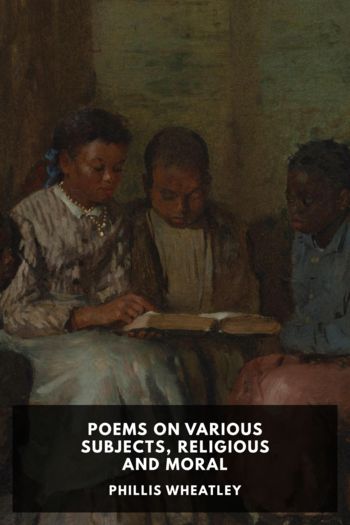Malaria and Rome: A History of Malaria in Ancient Italy, Robert Sallares [reading a book TXT] 📗

- Author: Robert Sallares
Book online «Malaria and Rome: A History of Malaria in Ancient Italy, Robert Sallares [reading a book TXT] 📗». Author Robert Sallares
Another important environmental factor for the larvae of Anopheles mosquitoes is the degree of salinity or freshness of the water. In Italy in antiquity marshes that were frequently flooded with seawater, such as those around Ravenna, were healthy, while those which did not have any natural or man-made connection with the sea, such as the Pontine Marshes, were pestilential. Similarly in early modern England marshes that were closed off from the sea tended to become breeding grounds for the mosquito ⁸⁹ Bonelli (1966: 678–9); Judson and Kahane (1963); Ravelli and Howarth (1988) and (1989).
Ecology of malaria
79
species A. atroparvus, a vector of malaria.⁹⁰ Vitruvius described the situation in Italy as follows:
When ditches have been excavated to provide outlets for (marsh) water to the seashore, and the sea rises during storms, overflows into the marshes and mixes the marsh water with seawater, the reproduction of the typical fauna of marshes becomes impossible . . . The Gallic marshes around Altinum, Ravenna, Aquileia, and other towns in such situations, next to marshes, illustrate this point, because they are extraordinarily healthy.
However, stagnant marshes which do not have outlets either in the form of rivers or ditches, like the Pontine Marshes, putrefy as they stand and emit noxious and pestilential vapours in such places.⁹¹
Similarly Strabo noted that Ravenna, although situated within marshes and dissected by rivers, received plenty of seawater during the tides, which periodically cleansed the marshes and eliminated ‘bad air’, dusaer≤a in Greek. Other ancient authors also described Ravenna. Sidonius Apollinaris noted that seawater came right up to the city’s gates on one side, while on the other side the water in the channels was extremely dirty. The larvae of Anopheles mosquitoes prefer clear water.⁹² There was a shortage of good drinking ⁹⁰ Dobson (1997). Compare the account in Pausanias 7.2.11, ed. Rocha-Pereira (1989), of how the silting up of the channel next to the city of Myus in Ionia by the river Maiander created an inland marsh cut off from the sea. The marsh became a breeding site for hordes of mosquitoes, forcing the abandonment of the city. This had happened by the time of Strabo 14.1.10.636C. Atarneus also suffered the same fate.
⁹¹ Vitruvius 1.4.11–12: Fossis enim ductis aquae exitus ad litus, et mare tempestatibus aucto in paludis redundantia motionibus concitata marisque mixtionibus non patitur bestiarum palustrium genera ibi nasci . . . exemplar autem huius rei Gallicae paludes possunt esse, quae circum Altinum, Ravennam, Aquileiam, aliaque quae in eiusmodi locis municipia sunt proxima paludibus, quod his rationibus habent incredibilem salubritatem. Quibus autem insidentes sunt paludes et non habent exitus profluentes neque flumina neque per fossas, uti Pomptinae, stando putescunt et umores graves et pestilentes in is locis emittunt. The words of the jurist Iuventius Celsus in Digest 17.1.16 are also sometimes quoted as evidence that Ravenna was healthy in the second century : cum Aurelius Quietus hospiti suo medico mandasse diceretur, ut in hortis eius quos Ravennae habebat, in quos omnibus annis secedere solebat, sphaeristerium et hypocausta et quaedam ipsius valetudini apta sua inpensa faceret (since Aurelius Quietus is said to have instructed a doctor, a guest of his, to make (at Quietus’s own expense) a ball-court, a sweating-room, and whatever else would be conducive to his own health, in the doctor’s own gardens at Ravenna which he was accustomed to visit every year). See also Borca (1996) with abundant further bibliography on Ravenna.
⁹² Sidonius Apollinaris, Ep. 1.5.5–6 to Heronius; Jordanes, de origine actibusque Getarum 29, 148–51, ed. Mommsen (1882), Monumenta Germaniae Historica. Auctorum Antiquissimorum Tomi v.
Pars Prior; Martial 3.56; Procopius, BG 1.1.16–23 (discussed critically by Fabbri (1991: 9–10) ); Michelini (1995); Manzelli (1997). Mazzarino’s idea, discussed by Michelini, that Ravenna owed its healthiness to the construction of the port of Augustus there for the Adriatic fleet, is untenable because Vitruvius makes it clear that other towns in the region, such as Aquileia and Altinum, were equally healthy. Consequently a factor specific to Ravenna itself cannot explain the salubrity of the entire region.
80
Ecology of malaria
Rovigo
Adria
N
o
P
River
GRANDE
BONIFICA
FERRARESE
Ferrara
Comacchio
A d r i a t i c
Valli di
Comacchio
S e a
Ravenna
E M I L I A
Imola
PINETA
DI CLASSE
Faenza
Cervia
Forli
R O M A G N A
Cesena
Rimini
SAN MARINO
Stia
Map 3. Ravenna and Emilia-Romagna
Ecology of malaria
81
water at Ravenna because of these hydrological conditions. Strabo regarded as a marvel the fact that the air over the marshes of Ravenna was healthy.⁹³ This suggests that most marshes in other parts of Italy were not healthy.
The coastal regions of northeastern Italy and the Po delta became heavily infested with both P. falciparum and P. vivax malaria in the late medieval period, as extensive alluviation gradually isolated towns like Ravenna and its marshes from the sea, thereby changing their chemical composition and altering mosquito breeding sites. Ravenna today is about ten kilometres from the sea, and the waterlogged Roman strata in the town are up to ten metres below the current ground level. Already in late antiquity and the early Byzantine period the immediate vicinity of the town had begun to dry up.⁹⁴ At that time Ravenna had a flourishing medical school which produced a series of commentaries on and Latin translations of the works of the Greek medical writers. It is quite possible that human interference with the natural environment, such as the bonifications attempted by Theoderic at the end of the fifth century , played a role in the





Comments (0)